#Kings Tailors
Text
instagram
2 notes
·
View notes
Text
Why is the most powerful being in Hell being a total goober cutie who loves his family so attractive man

Mans is the LIVING EMBODIMENT of the "I can be your angle or yuor devil" meme

Was this character legit tailor made for me like what the hell (ha)

#hazbin hotel#lucifer morningstar#sidrabbles#the way he's married and adores his tall as fuck wife while being a literal short king#LIKE I'VE LOVED SHORT GUY/TALL GIRL SHIPS MY WHOLE LIFE#LEN X MIKU YOU WILL ALWAYS BE FAMOUS#HE'S TAILOR MADE TO LEASH ME ISTG
807 notes
·
View notes
Text
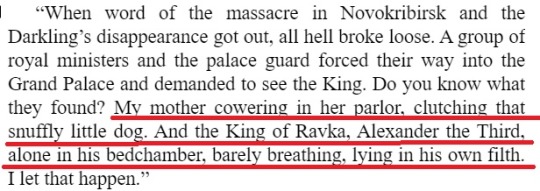
Siege and Storm- Chapter 11 (Leigh Bardugo)
Good.
“A lack of gratitude is unbecoming in a servant. You should wear the jewels my husband gives you.”
The Tailor
They both deserve much worse.
“You ungrateful whore,” sneered the King. ... “She is a servant, Nikolai. I didn’t have to force her.”
Ruin and Rising- Chapter 7

#Grishaverse#S&S Chapter 11#Queen Tatiana Lantsov#King Alexander III Lantsov#Nikolai Lantsov#grishanalyticritical#The Tailor#R&R Chapter 7#Genya Safin#Siege and Storm#Grisha trilogy#V#books#quotes#Leigh Bardugo
75 notes
·
View notes
Text


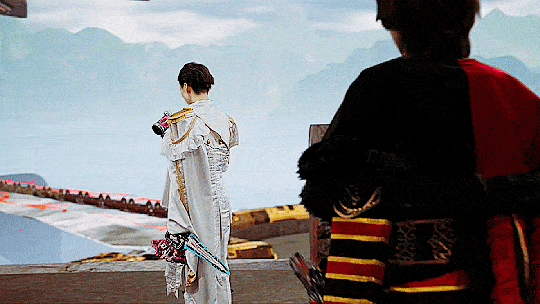



subtext
+ bonus
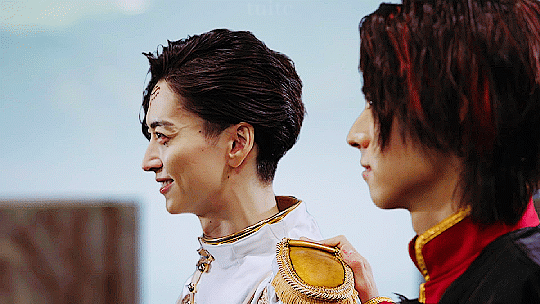
#king ohger spoilers#super sentai#king ohger#kingohger#ohsama sentai king ohger#ohsama sentai kingohger#jeramie brasieri#jeremy brasieri#gira husty#gira hastie#kuwagata ohger#spider kumonos#tokuedit#please do not repost#umbrella.edits#umbrella.gifs#umbrella.posts#subtitles added by me#translation: over-time#king ohger was tailored completely to me i think#it's becoming a signature thing for gira to pat jeramie's shoulder and i hope they have jeramie do it once at some point
104 notes
·
View notes
Text

Steve McQueen, 1963
#steve mcqueen#tailoring#aesthetic#vintage#old school cool#60s aesthetic#60s vintage#60s icons#60s fashion#gentleman#style#debonair#suave mf#king of cool
201 notes
·
View notes
Note
How do you imagine ravens future to be? Like would she get married or not,run a music career,have kids,etc
Well in tlosh Raven says that she wants to become a storyteller which was kinda weird to me because raven never really showed any interest in that, besides rewriting her own destiny which is really just a fancy way of saying living.
And I thought that Shannon just decided that would be good symbolism/end the ravens character arc. Until I thought more about it. Like storytelling isn’t just ink and parchment.
So I think during her final years at eah her and melody create a musical duo with Melody (PLZ THEIR VOICES WOULD BLEND SO WELL TOGETHER) which eventually turned into a band that was kinda just recording different songs that (mostly) raven wrote and it was different ppl on each track
Some of the ppl I could see would be Cupid on lyre, Jillian on harp, Ashlynn flute, raven guitar / piano, Maddie and Lizzie on random wonderlandian instruments and melody on literary everything.
I don’t think all of those instruments would be in every song (those r just the characters who I think canonically know play those instruments) but yeah
And raven would be writing n recording songs all throughout eah and I think that she would become pretty famous
I think that her and dexter would stay together and eventually marry
I think that they wouldn’t try for kids but if raven got pregnant they would keep it.
I could see them adopting tho 
I think that every one fsr expected raven to change her last name to charming, but both raven and dex changed their last name to goodking
#asks#ever after high#eah#raven queen#dexter charming#shannon hale#the legend of shadow high#tailor quick#melody piper#good king#eah good king
26 notes
·
View notes
Text
I'm sorry but there's absolutely no way you can look me in the face (not in the eyes because eye contact is uncomfortable) and tell me Nikolai Lantsov wouldn't be a theatre kid.
#i mean come on#he was playing privateer for how many years#going by a different name and being tailored to look different and everything#i know he wanted to help his country outside of the court but like#he totally had fun with it#and those dramatic lines???#“i keep to a strict diet of ill-advised enthusiasm and heartfelt regret”???#he literally radiates theatre kid energy#nikolai lantsov#paddy gibson#zoyalai#shadow and bone#seige and storm#ruin and rising#six of crows#crooked kingdom#king of scars#rule of wolves#grishaverse#nikolai duology#netflix shadow and bone#shadow and bone season 2#shadow and bone season 3#six of crows spin off#soc spinoff
107 notes
·
View notes
Note
It would be really funny to put Lucifer through a gay crisis
I had no real interest in hazbin until I saw how pathetic meow meow coded they made Lucifer. What a sad wet sack of a man. I want to put him in a jar and shake it.
making him go through a sexuality crisis would be peak comedy
#You like girls??? We have so much in common!!#Sir you are the KING OF HELL#Stop acting so baby girl!#He’s tied for my fav with Alastor because I’m predictable#Smiley asshole canibalizar with so many secrets??#It’s like he was tailored to me specifically#hazbin hotel#Vrrm vrrm#Bfiasc aus
24 notes
·
View notes
Note
People ship scav king and arti?
I am only now realizing the possibilities
YES JOIN US PLEASE, this ship desperately needs more ppl on board. i think its literally just me and like 2 other people lmao help
#rain world#artificer#scavenger king#rw regicide#idk how the rain world fandom sleeping on the potential of this ship so hard#yall have a universe tailor made for enemies to lovers shenanigans#let them take turns murdering each other until they catch feelings
73 notes
·
View notes
Text
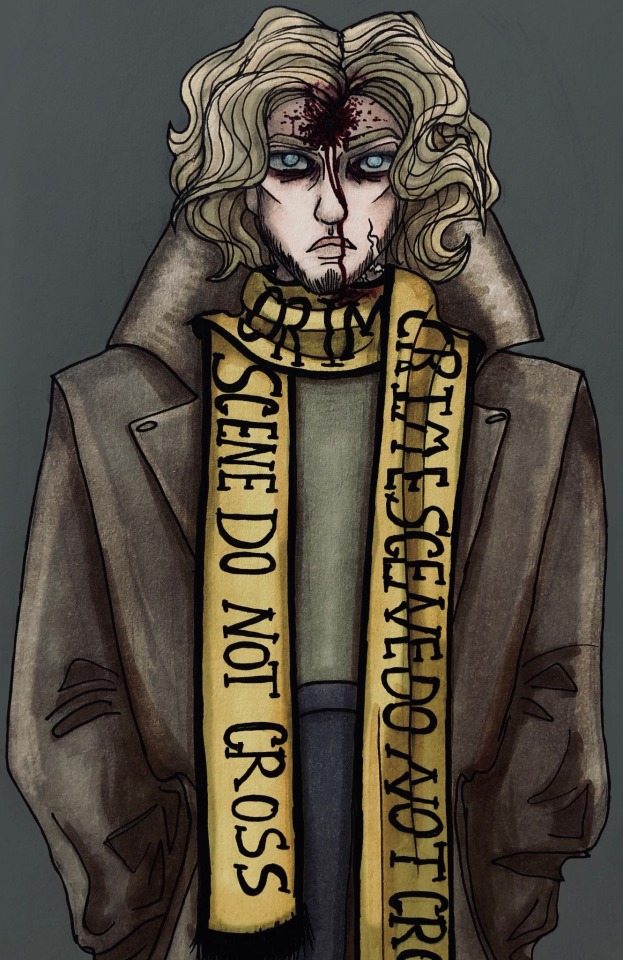
I have no excuse or explanation for this one, it came to me in a vision and I will not be elaborating.
Mike’s Scarf
#the magnus archives#Mike crew#tma#he came back wrong (again🙄)#the coat is too big cause I imagine he found a really cool coat in a vintage store or something and refused to have it tailored#we love a short king#art#the vast#my art#michael crew#podcasts#sketch#portrait#fanart#drawing#blood#traditonal art#artists on tumblr#rusty quill#horror podcast#I made him less fruity than my last drawing of him and I’m sure I’ll pay for that decision at some point
22 notes
·
View notes
Text
uhhhh *drops this here*

#where tf does the clothes come from?? from this lady. she always- makes everyone clothes. king dedede robe is made from her and she-#- is mighty proud of that#anyways uhhh...#waddle dee oc#kirby oc#if there is a tailor dee in canon. shhhhhhhhhhh no it doesnt...
20 notes
·
View notes
Text

took only the details from the model i liked & ignored what i didn't to update my garte. garte 2.0
#big fan of all the details on his vest the tailoring.. the lines.. the fact that the front & back are different colors#will definitely include the tailoring on his vest from hereon out its very fun. also love how on model his pants pool below the knee it#adds to his short king swag#de#disco elysium#garte the cafeteria manager#lawrence garte#my art#canon body IGNORED in my heart he has always been pear shaped and always will be pear shaped. hill i will die on
109 notes
·
View notes
Text
Some scholarly notes about the Grimm fairytales (2)
A follow-up of this post.

The Frog King or Iron Henry (Der Froschkönig oder der eiserne Heinrich)
This story belongs to the AaTh 440, "The frog-king".
The story first appears in the 1810's manuscript, written by Wilhelm - it was probably told by Henriette Dorothea "Dortchen", Wilhelm's future wife. A second version, called "The frog prince", had been told to them by their friend Marie Hassenpflug and was published in the 1815 edition as the thirteenth tale, before being moved to the notes of the 1822 due to its too-great similarity with the KHM 1.
This fairytale was originally called "The king's daughter and the bewitched prince". The 1810 manuscript has, written by Jacob right next to the title, "The frog-king", while the paper on which he had placed all his notes about the fairytale bore the name "Iron Henry". The evolution of this fairytale is very interesting because it testifies the brothers' love and care for details, hich had the story double in sie throughout the editions. In the final text we have, for example, a long sentence describing how the princess sees the ball fall into a well so deep she can't see the end, and about her crying a lot and lamenting, etc, etc... In the 1810 manuscript it was just one short sentence "She stood near the well and she was sad."
The major editing of this tale was the removal of the erotic motif from the tale's ending. Originally, the frog asked the princess the authorizaton to sleep in her bed, and right after the frog became a human it was written "the princess joined the prince in bed". This, plus the addition by the Grimms of moral lessons delivered by the father (the king tells things such as "You must always keep your promise" and "You must not disdain the one who helps you"), completely changed the goal and purpose of the tale - it was originally about setting free an animal husband, but the Grimms turned it into a moral tale to learn a virtuous behavior.
The brothers Grimm considered this fairytale to be the oldest and most beautiful of their collection. Allusions to the frog-king tale can be found as early as the Middle-Ages and the 16th century. In the 1801 edtion of the 1548 Scottish book "Complaynt of Scotland", a note evokes how a tale is similar to "The Frog Prince" due to having a well, the presence of magic, and a frog complaining in rhymes. In this Scottish version, a girl is sent by her stepmother to fetch water at "the well of the world's end". There she meets the frog, who tells her it will offer her water only if she agrees to marry it - if not, the frog will rip the girl apart. The brothers Grimm themselves noted various literary sources for their tale, that they used in their compilation work. The name of Henry (Heinrich) comes from the novel "Der arme Heinrich" by Hartmann von Aue. They also listed the "Froschmeuseler", a didactic epic by Georg Rollenhagen depicting a war between frogs and mice: the association of sadness with "rings of iron" comes from this text, as well as the very name "frog-kng" which is found in the title of the second chapter "Tale of the encounter between Thief-of-Crumbs, son of the mice-king, with the frog-king".
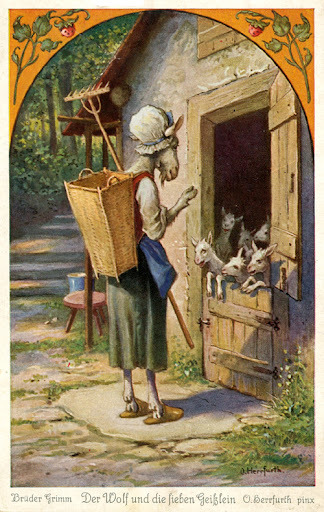
The Wolf and the Seven young Goats (Der Wolf und die sieben jungen Geiblein)
It is the AaTh 123, "The wolf and the lambs".
Collected in the "region of Main" according to the Grimm, it is very likely that the brothers Grimm received this tale from someone of the Hassenpflug family, as they knew the French fables of La Fontaine which correspond to this fairytale. In the 5th edition of their book, the brothers Grimm modified their story due to the publication in 1842 of an Alsacian tale by Ströber, "Die sieben Gaislein", "The seven young goats" (collected in Volksbüchlein, "The Folks' Small Book) - Wilhelm Grimm borrowed several expressions from this text. The brothers Grimm listed this Alsacian tale in their notes.
In their notes the brothers Grimm listed a Pomeranian version about a child who, when his mother is out, is swallowed by a sort of bogeyman known as "The children's ghost". But since the ghost eats stone at the same time, he becomes slow and heavy - he falls and the child can escape his belly unharmed. The brothers Grimm also listed variations collected/written by Boner in his Edelstein, and by Buckhard Waldis - as well as the La Fontaine fables. They also knew of a French fairytale, from which they noted a passage where the wolf asks a miller to turn her paw white with flour, and since the miller refuses, the wolf threatens to eat him. The Grimms linked the episode of the wolf's belly filled with stones with the legend of a Nereid called Psamathe, who sent a wolf destroy the flocks of Peleas and Telamon, only for the wolf to be petrified.
This tale, like many others within the Grimm's collection (it is especially comparable "Cat and Mouse in Partnership) is aimed at educating young children, with the narrator highlighting how children should be wary and distrustful of the wickedness and cowardice of men. Unlike other versions and predecessors of the tale, the brothers Grimm insist on the mother's role as a teacher, and on the fact that she saves her kids.
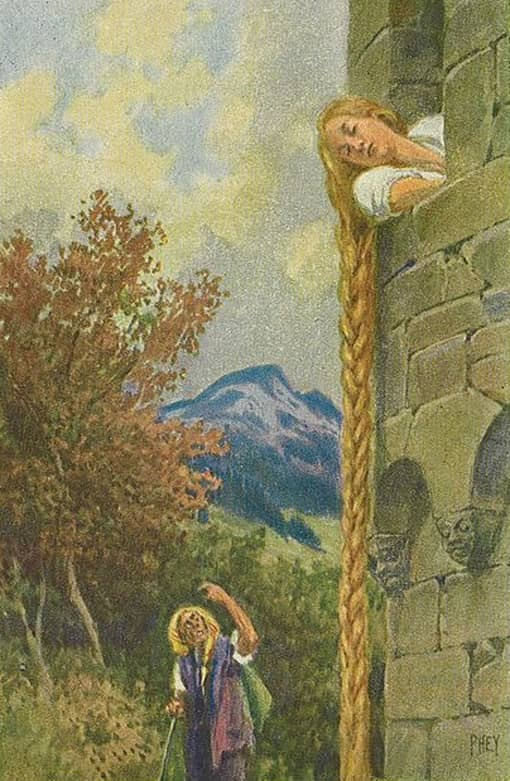
Rapunzel
It is the AaTh 310, "The maiden in the tower".
The literary sources of this fairytale are well-known. It was preceeded by the French literary tale "Persinette", by mademoiselle de La Force, itself inspired by Basile's story "Parsley Flower". In their notes the brothers Grimm explained they took inspiration from the almost-literal German translation of mademoiselle de La Force's story by Friedrich Schulz. However, in quite a misunderstanding, the brothers admired this tale as being an obvious "folktale" coming from the "oral tradition" - when we know it was a literary fairytale, though based on a folkloric motif.
The text was heavily edited after the many criticism the first edition of the book underwent - the scene depicting the prince's relationship with Rapunzel was regularly changed. In 1837 it is written that the prince asked Rapunzel to marry him almost right away, and she agreed since he was young and pretty, and they "held hands". In 1819, it was written that they lived together in "joy and pleasure" for a certain time, and "loved each other like woman and wife", and the "fairy" only realizes something is up when Rapunzel blurts out it is easier to make the prince climb than her "godmother". In the 1812 edition, it is said that Rapunzel and prince lived together in "joy and pleasure", but no mention of any marital couple whatsoever - and Rapunzel betrays her condition to the "sorceress" because she complains about her clothes getting too tight.
The Grimm noted that many versions of the "girl in the tower" fairytale existed, but with a different opening relying on the "forbidden room" motif: the witch punished the girl by locking her up in a tower because she had opened a door the witch explicitely forbade her to. The Grimm also listed several stories (outside of Basile's version) where a mother (sometimes a father) bargains their future child to satisfy a temporary craving - such as the Nordic "Alfkongs-Saga", where Odin offers Signy's wish for the better bear in the world in exchange of what is "between her and the barrel", aka the child she bears. In a book of Büsching we find a girl named "Petersilie" (Parsley in German) which loves eating prasley more than anything in the world and brushes her long hair by a window. The idea of using hair as a rope or ladder, long before Basile used it, seems first recorded by from the "Book of the Kings" of the poet of Persia Firdoussi, in the 10th century: the hero, Zal, joins the beautiful Roudebeh by climbing up her braids.
The name the sorceress wears in the German tale, "Frau Gothel", had been explained by the Grimm in such a way: "The godfather is not only called Vater (father) but also Pathe (godfather/"parrain" in French), or Goth or Dod ; the baptized child is also called "Pathe" or "Gothel", hence the confusion of the two within the legend". So, the dominating hypothesis (which seems confirmed by the variations of the fairytale) is that "Gothel" means "godmother".
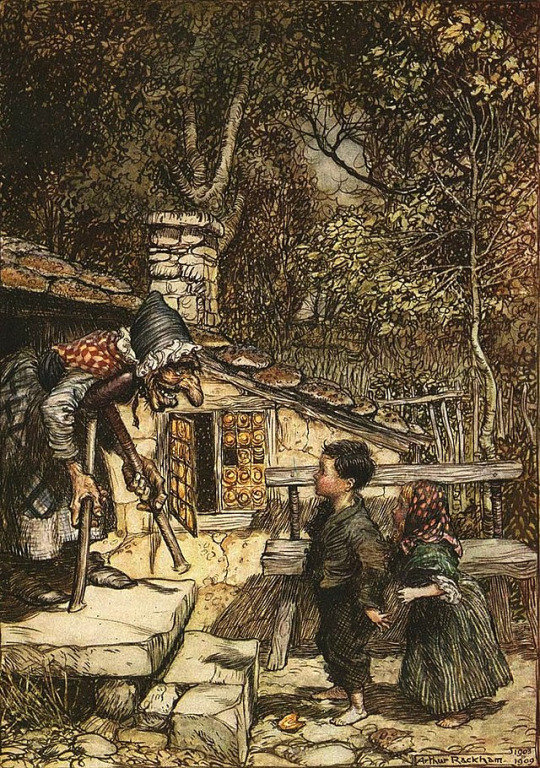
Hansel and Gretel (Hänsel und Gretel)
It is of course the AaTh 327 A, "Hänsel and Gretel" (a subtype of "The children and the ogre"). It also covers the AaTh 1121, "Burning the witch in her own oven".
In the 1810 manuscript this fairytale was called "Little brother and Little sister", a name that would later be reused by another famous Grimm fairytale (KHM 11). It seems that one of the reasons for the Grimm's big edits on this tale was the publication in 1842 of the Alsacian version of this story by August Stöber, "The little house of pancakes" (Das Eierkuchenhäuslein) - which itself was inspired by the Grimm's original publication of "Hansel and Gretel" (full loop here). Wilhelm Grimm notably borrowed several turn of phrases from Stöber.
The motif of the children abandoned in the woods can be found back in Basile's Nennillo and Nennella, though the extension to the encounter of a child-eating monster is rather present within Perrault's Petit Poucet and madame d'Aulnoy's Finette Cendron (both also contain the motif of the treasures inside the ogre's house). While we know the Grimms were aware of Perrault's story, we also know that madame d'Aulnoy's fairytales, including "Cunning Cinders" had been brought to Germany by ther adaptation for the German branch of the "Bibliothèque Bleue" - Blaue Bibliothek. Ludwig Bechstein's own version of "Hansel and Gretel" was very famous - and he actually wrote it inspired by the German translation of Stöber's own tale.
The motif of ashes, crumbs or seeds left behind to tell the way is recurring within the brothers Grimm fairytales: it also appears on the KHM 40 (The Robber Bridegroom) and 169 (The Hut in the Forest), as well as in their first "Legend for children". This motif can be found back in German literature to 1559's Gartengesellschaft (The company within the garden) by Martin Montanus, where it appears in the tale "The small earth-cow", Das Erdkühlein.
It is recognized that this fairytale is the second most popular and famous Grimm fairytale right after Snow-White. It was heavily illustrated - first by none other than Ludwig Emil Grimm himself (another brother of the Grimms). As we said before, Bechstein's own fairytale was a strong "rival" to the Grimm's, and was illustrated by Ludwig Richter in 1853. The motif of the "bird leading to the Ohterworld" is found back in the KHM 123 (The Old Woman in the Wood), and in both cases the fact the bird is white indicates that it is an Otherworldy animal.
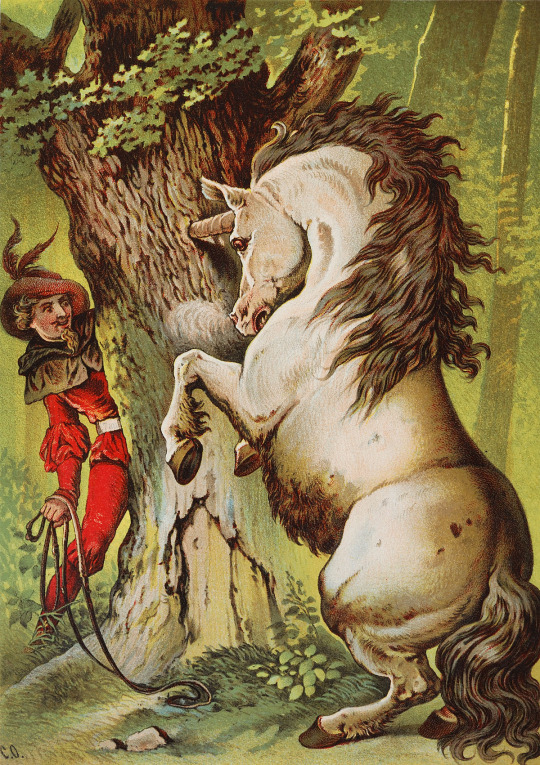
The Brave Little Tailor (Das tapfere Schneiderlein)
This fairytale belongs to many different Aa-Th types: 1640 (The brave little tailor), 1051-1052 "Curb, cut and move a tree", 1060-1062 (Throwing-stone conquest), 1115 (Attempt to kill the hero in his bed).
The 1810 manuscript began with this tale as its opening, probably as an homage to Brentano, since Wilhelm Grimm found this tale within his library, in a book called "Wegkürtzer", by Martin Montanus.
Among the modifications of the 2nd edition, a very interesting one is the addition of a sentence closing the first paragraph "and his heart moved with joy like the tail of a small lamb". This sentence comes from a novel by Christian Weise calle "The three most mad madmen in the whole world/The three most foolish fools in the whole wide world" (1762). Wilhelm Grimm explained this, as well as several other similar "borrowings", in the preface of the sixth edition, as his desire to insert in his tales specific sentences and expressions he knew to be typically German.
The brothers Grimm notd that Montanus' Wegkürtzer was frequently alluded to within the Renaissance literature and the baroque one - for example, when Johann Fischart translated in German Rabelais' Gargantua he inserted the sentence "I will kill all these flies, nine at once, like this tailor once did." It was also evoked in the "Simplicissimus" of Grimmelshausen, but references to the Little Tailor story go back to the Middle-Ages. The episode of a giant crushing a stone until water comes out of it is found in "Brother Werner", from the Codex Manesse (which compiled German Minnesang, courtly poetry) ; and Heinrich von Freiberg's Tristan describes at one point the hero crushing a cheese until juice comes out of it. Montanus' text was also used by Ludwig Bechstein in his book of German fairytales. One can compare the story of the Grimms to Tabart's "Jack the giant-killer" and Afanassiev's "Foma Berennikov".
The measurements in this story make no sense at all. The tailor buys four half-ounces of marmelade. Given an ounce was roughly 32 gr, the tailor bought 60 gr roughly... Not a quarter of a pound, as he claims. The reason for this incoherence is because, before 1854, a "pound" varied depending on which area of Germany you were into (it was 467 gr in Berlin, 510 in Nuremberg). It was only in 1854 that the value of the pound was unified in Germany, at 500 gr. Finally we note the presence at the end of the tale of the common European belief n the "Wild Hunt".

Cinderella (Aschenputtel)
Of course, it is the Aa-Th 510A, "Cinderella".
As early as the first edition, this fairytale was a mix of several variations. In their notes, the brothers listed nine different versions of the tale. One of them is quite fascinating: the opening scene of the mother's death and her promises of help is missing, the story begins immediately on the heroine's misfortunes. The end of the version also greatly differs and enters the domain of the KHM 11 "Little-brother, Little-sister". Soon after his wedding with Cinderella, the prince forbids her to enter a specific room of the castle - but encouraged by her sister, she opens the room when the prince is absent. It contains a fountain of blood that Cinderella's sister uses for an evil use: after the queen gives birth to her first child, her sister throws her in the fountain and replaces her in the bed. But the guards of the castle hear the moans of Cinderella, rescue her and the wicked sister is punished. Another version, from Mecklembourg, has an ending which makes the tale close to the legend of saint Genevieve of Brabant: Cinderella's stepmother and stepsister steal away Cinderella's two first children and replace them with animals ; the third time she gives birth, they order the gardener to kill the queen and her child, but he rather hides them in a grotto in the woods, where the child is fed by a doe. One day the child, old enough, goes to the castle to speak to his father, revealing to him the fate of his mother.
Another version, this time from Paderborn, begins in a way very similar to "Snow-White": a queen wishes to have a child as red as a rose and as white as snow. She gets her wish, but then her servant pushes her outside of the window, to replace her as the king's wife. The usurper gives birth to two daughters, and from then on we return to the classical Cinderella tale - her dead mother helping her from beyond the grave by offering her a key, opening a hollow tree where Cnderella finds what she needs to wash herself and dress up pretty for the church (plus a prayer book). Büsching evoked the existence of another version in the Zittau area, where Cinderella is a miller's daughter that is forbidden to go to church, and where it is a dog that denounces the false fiancée. Outside of all these oral sources, the brothers Grimm took inspiration, of course, from Charles Perrault's Cinderella, as well as from the first German literary record of the Cinderella story, "Laskopal and Miliwka", published in an anonymous collection of legends in 1808 (Sagen der böhmischen Voreit aus einigen Gegenden alter Schlösser und Dörfer").
From the second edition onward, the brothers Grimm heavily edited the story. They removed all the words and passages that referenced too much Perrault's version, replacing them by elements taken specifically from the three versions they collected in Hesse (such as the demand for a branch of a nut-tree, and the motif of the tree growing on the grave). In the 1812 edition, it was Cinderella's own mother who advised her daughter to plant a tree on her grave, and who predicted that this tree will help her in the future. Throughout the rewrites, Wilhelm Grimm heavily insisted upon the heroine's virtues, accentuating them so that they would fit the feminine bourgeois ideal of the time.
The first European record of this tale is Basile's "The cat of the ashes", and other famous literary versions include Perrault's Cinderella, madame d'Aulnoy's Cunning Cinders, as well as Ludwig Bechstein's Aschenbrödel. These versions were massively spread throughout Europe, notably due to the "peddling literature", the cheap books sold by peddlers: they helped the "Cinderella" fairytale type becoming as popular as it is today, and it seems very likely they influenced all the versions of the tale that came after them.
In their notes, the brothers Grimm explicitely compared the motif of the shoe in Cinderella with the legend of Rhodopis, who had her shoe stolen by an eagle, and the pharaoh that found it had her owner searched throughout Egypt. However the motif of the animals helping a persecuted heroine (especially when it comes to splitting grains) is very common, and has been popularized by the Roman tale of "Cupid and Psyche".
This fairytale is closely tie to the KHM 130, "One-Eye, Two-Eyes and Three-Eyes", both sharing the idea of a young girl humiliated by her sisters, and who obtains a social ascension as a form of compensation. A. B. Rooth studied the evolution of the Cinderella fairytale-type, and its relation with other fairytale-types: they determined that it is very likely the "Cinderella" story was originally told as a sequel to the "One-Eye, Two-Eyes, Three-Eyes" story-type. Later, the second part of this story gained its own autonomy, and became the "Cinderella" we know today.
The sexual connotations within the motif of "trying on the shoe" has been repeatedly noted and analysed since the Grimms published their story. Jacob Grimm himself saw in this the remains of an archaic Germanic betrothing ritual. Heinz Rölleke highlighted another cultural ritual that involved the future husband of a bride removing her old shoes before marrying her. The idea of the slippers tied to a wedding is also found within the KHM 133 (The Shoes that were danced to Pieces).
The name of the heroine in Germa, "Aschenputtel" designates a type of kitchen girl who searches throughout the ashes, and thus "rolls" herself in them - but it also means figuratively an insignifiant and a dirty girl. It seems to derivate from the greek "achylia", cinders/ashes, and "puttos", female genital organs. A combination echoed by the French name "Culcendron", "Ashen-butt". By extension, the name "Aschenputtel" can also designate the younger brother when he is disdained by his brothers and considered to be an idiot by his family: there is a lot of male Cinderellas in folktales, especially in Northern and Central Europe, but also in all German-speaking countries.
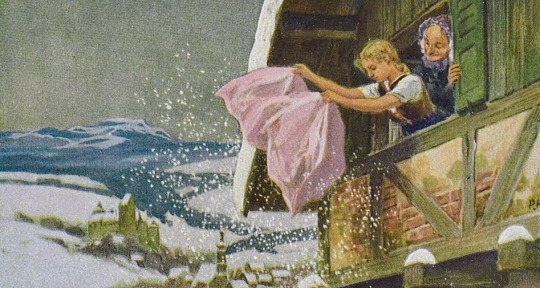
Frau Holle
Belongs to the AaTh 480 "The kind and unkind girls".
This story was told to Wilhelm Grimm by his future wife, Henrietta Dorothea Wild, who was then 18 years old. A secondary source was a tale told to their by the Hanovre pastor, Georg August Friedrich Goldmann - this second version contained the episode of the rooster saluting the girls. The second edition of the brothers Grimm's book added several details to this story to "rationalize" it - notably the Grimm added of their own an explanation as to why the girl jumps into the well.
This fairytale comes from Hesse and Westphalia. The brothers Grimm listed in their notes four other versions of it - and the first is more noticeable, because it echoes "Hansel and Gretel", as the house where the girls arrive is made of pancakes (crêpes). Older literary versions of "Frau Holle" can be found in Basile's Pentamerone (The Months, The Three Fairies), as well as within a French fairytale written by Gabrielle-Suzanne de Villeneuve, "Les nymphes" (The Nymphs). Translated in German in 1765, Villeneuve's fairytale notably inspired the Grimms when they composed their 1810 manuscript - they adapted her tale as their own story called "The marmot". Before the brothers Grimm, "ancestors" of "Frau Holle" can be found in various German fairytales, present in the collections of W. Reynitzsch (1802) and Benedikte Naubert (1789). Ludwig Bechsten did his own version of the fairytale (Gold-Mary and Pitch-Mary, Die Goldamaria und die Pechmaria) which had a huge success in Germany.
This fairytale belongs to a wide series of tales in which young girls leave their house to enter a far-away country which might be the Otherworld, and where they become the servants of a spernatural being. There, by performing tasks in a disinterested manner, they are rewarded. As with other fairytales, "Frau Holle" shows how the Otherworld and our world are inter-dependant with each other. "Frau Holle" had a huge mediatic success: it was adapted several times as movies, it is heavily present in children's literature, and it was heavily illustrated. The character of Frau Holle ("Holle" derivading from the Middle-High-German "hulde", "benvolent") is an ambiguous character, and shares several characteristic with Germanic water-spirits. She is a giver of supernatural gifts and goods, but she also punishes the wicked. This supernatural character is very present in German legends, especially in the oral tradition which associates her with the works of weaving and spinning. She might have her roots in the figure of a spirit in charge of women's initiation rituals.

Little Red Riding Hood (Rotkäppchen)
It is of course the AaTh 333: "Little Red Riding Hood".
The two versions the brothers Grimm used to create this story were told to them by Johanna Isabella and Marie Hassenpflug. Isabella's version was most notable for being an obvious transposition of Charles Perrault's fairytales - with two elements changed. The tragic ending was modifed so that the girl and her grandmother would be saved ; and the erotic connotations of Perrault's fairytale (where the wolf was presented as a dangerous seducer) were removed.
Charles Perrault's fairytale was also present in German literature through Ludwig Tieck's verse tragedy "The life and death of little Red Riding Hood" (Leben und Tod des kleinen Rotkäppchens), published in 1800. As for Ludwig Bechstein, he inspired himself from the brothers Grimm tale to create his own "Little Red Riding Hood". M-L-Tenèze has worked on collecting all the oral and popular versions of Little Red Riding Hood in France, its birth-country, and has identified its original format as it must have been told before Perrault: usually they end like his tale in a tragic way for the girl, but rarely she notices she is in bed with a monster and manages to trick it to escape. However a detail Perrault erased and that is present in these versions is how the wolf keeps a bit of the grandmother's flesh and blood, that he offers to the little girl as food.
The first version of this story, in the original edition of the brothers Grimm book, was much more didactic than the one we have today, heavily insisting on how the little girl should have obeyed to her mother, and how there are specific ways to interact with strangers on the road - and in fact, it seems that the reason this fairytale was so popular and widespread was precisely because of its didactic nature. Because everybody knows the "original" version of the Grimm better than the final one, their second and revised text that shows a heroine able to learn from her mistakes, and ending up defeating the wolf of her own without any outside help. It should be noted that the first version of the Grimm tale had an echoing motif with the KHM 5 "The Wolf and the Seven Young Kids".

The Musicians of the Town of Bremen (De Bremer Stadtmusikanten)
They eblong to the AT type 130 "The animals find a house for the night", more specifically the AT 130 B, "The animals flee after a death threat".
This fairytale, like many of those present in the brothers Grimm collection, was actually the fusion of two distinct stories they collected. The brothers Grimm described in their notes a literary source for this story: a long extract from "Froschmeuseler", a didactic epic by Georg Rollenhagen published in 1595 and which had animals as protagonists. In this text however, it is a dog that leads the six other animals (an ox, a donkey, a cat, a rooster and a goose). For this poem (of 20 000 verses) Rollenhagen himself had another literary inspiration: a first-century epic describing a war between frogs and mice.
The nicknames of the various animals were only added in the third edition of the book. The notes of the brothers contain a third version of the tale they did not use, and which mostly differs when they arrive at the robbers' house. Instead of chasing them away, the animals enter peacefully in the robbers' den, play music and are fed as a reward. Then the robbers leave, and when they return they send one of theirs to check if everything is alright in the house - and he suffers the fate described in the Grimm's final tale. There are other versions of the story where there are only two animals involved (a dog and a rooster), who get involved with a fox that the dog ultimately kills. In fact, the oldest versions of this tale all deal with domestic animals confronting, not human criminals, but rather savage animals of the forest. Outside of Rollenhagen's text, another literary precedent was a poem of Hans Sachs from 1551, where the house is inhabited by wolves.
The title of this story seems to refer to traditional mockeries of the music of the town of Bremen, which was a very famous city at the time. Anti-Aarne wrote an entire monography about this tale-type, "The travelling animals" (Die Tiere auf der Wanderschaft) where he highlighted how this story was the Western "sibling" of a more Oriental fairytale-type, the AaTh 210 "The rooster, the chicken, the duck, the pin and the needle are travelling". This tale is mostly present in the Far-East (Middle-East?), and very rare in Western Europe - but it is still present within the brothers Grimm's collection as the KHM 10 (The Pack of Ragamuffins), 41 (Herr Korbes), and 80 (The Death of the Little Hen). The oldest Western form of this other fairytale type is within the Latin poem by Nivard of Gand, 1150's "Ysengrimus", where animals considered too old are banished by their masters or about to be killed, and flee into the forest. The "Roman de Renart" (the Roman of Reynard) also contains ths motif in its eighth branch - and the ingratitude of mankind towards the creatures that served them all their life is also a theme of the KHM 48 (Old Sultan).
#german fairytales#grimm fairytales#brothers grimm#the frog king#rapunzel#hansel and gretel#cinderella#history of fairytales#evolution of fairytales#the musicians of the town of bremen#little red riding hood#frau holle#the brave little tailor
16 notes
·
View notes
Text

rotates him on my mind. he did so much for the community and he doesn’t even know it
#icarus speaks#he was the BLUEPRINT!!!!#i have no excuse for this i just wanted to andor post#and yes i had to choose the most atrocious outfit i could find on him#your family is rich PLEASE just hire a tailor or something king 😭
65 notes
·
View notes
Text

#HappyBirthday #colinfirth #actor #prideandprejudice #theenglishpatient #BridgetJonessDiary #sheakspeareinlove #LoveActually #asingleman #Kingsman #TheGoldenCircle #femmefatale #nannymcphee #mammamia #herewegoagain #achristmascarol #thekingsspeech #tinkertailorsoldierspy #marypoppinsreturns #thesecretgarden #empireoflight #ryelane @hbomaxla
#happybirthday#colin firth#actor#pride and prejudice#bridget jones diary#sheakspeareinlove#love actually#asingleman#kingsman#thegoldencircle#femme fatale#nanny mcphee#mamma mia#here we go again#a christmas carol#the kings speech#tinker tailor soldier spy#mary poppins returns#the secret garden#empire of light#rye lane
45 notes
·
View notes
Note
AHA YOU DID PUT THE ASK GAME BACK UP
I humbly request something with Saville and Galen because my beloveds 🤲
I DID and took so long to respond to this lol. But! Since you didn't specify an AU I decided to explore a concept I came up with in the shower the other day: Valiant Cinderella au (featuring Ever After vibes, The Flight Of Swan characters, and one subtle reference to my liveblog)
I’d only taken my eyes off of Will for a second. We were in the market— he and I and Corbin, my stepbrother who hadn’t been convinced to hate me, despite my stepmother’s best efforts.
Will was family too, after a fashion. I’d found him, just a street urchin fighting dogs for food, and brought him home under the guise of a servant. Really, I’d just wanted to keep him safe, even if I couldn’t protect myself.
He was a hard worker, but too eager to rush ahead. I’d only looked away to barter for bread for a minute— one minute! And then I heard his voice shouting my name, and turned to see soldiers dragging him away.
King Eldin was supposedly a weak king, weaker than his hard-headed brother had been. He wasn’t a bad man— but he was easily manipulated, a fact that had been taken advantage of by Lord Leymonn, one of the top advisors in the castle. And Lord Leymonn had little tolerance for the parentless urchins wandering the streets. Which Will wasn’t— but clearly the soldiers didn’t know that.
Dropping my basket, I bolted towards the soldiers, ignoring Corbin shouting for me to be careful. I couldn’t let them take Will. I couldn’t.
The soldiers were shoving him into a cart as I approached, heart pounding with terror. I hated being scared, and that fueled me enough to shout, “Stop! What are you doing?”
The two soldiers paused, one still keeping a firm grasp on Will’s arm as the two of them looked at me. The older of the two, brown eyed with a beard, lifted an eyebrow at me. “Arresting this thief.”
“He is not a thief,” I protested, glaring at them. “Do you arrest all children you see because you suspect they may be thieves? He’s a servant in my stepmother’s household. Let him go.”
“Lord Leymonn has ordered that street urchins—”
“Hang your Lord Leymonn,” I spat out, and was surprised to see a look of amusement cross the older man’s face. The younger looked affronted, and was opening his mouth to respond when a third voice cut through our conversation.
“Orion, Hayden, what’s going on here?”
I turned, ready to fight— and the words shriveled up in my mouth.
Fine Coat. Sky above, it was Fine Coat— the noble who I’d met six months earlier on the road to Reggen, traveling back home with my father. Before he’d remarried a witch woman and then fallen ill, leaving me in her hands.
He wouldn’t remember me. He couldn’t. No matter how much I may have annoyed him at the time.
“Lord Verras,” the younger man said, straightening a little. “We’re arresting this street urchin. Lord Leymonn’s orders— we’re to keep the streets as free of thieves as possible, sir.”
“He’s not a thief,” I broke in, my fear for Will overwhelming my fear that Fine Coat would know who I was. “He’s a servant in my stepmother’s household, and he wouldn’t steal anything.”
“He’s a street rat,” the younger guard said.
“He’s a child,” I snapped, glaring at him. “Or is that an instant sign of guilt in the eyes of your precious Lord Leymonn?”
Out of the corner of my eye, I saw Lord Verras and the older man exchange a look that I couldn’t read. Hardening my heart against fear, I turned towards him. “He’s just a child. He hasn’t done anything, you can’t arrest him. Or have the nobles already forgotten what justice is?”
The younger guard gaped at me, as shocked by my audacity as my pounding heart was. Lord Verras regarded me, with eyes that almost seemed to look through me. I held myself straight, refusing to look away. I wouldn’t back down.
“You have such a low opinion of our royalty?” His voice was calm, curious.
“I have a low opinion of anyone who would lock up a child,” I told him, and he nodded.
“Fair enough. Release the boy.”
“But Lord Leymonn will—”
“I will deal with Leymonn,” Lord Verras said, and I didn’t miss the look the two guards exchanged. The older one nodded to his companion, who let go of Will’s arm.
He scrambled free, tumbling into my arms, and I pulled him close, trying to hide my trembling. “Thank you,” I told Lord Verras.
“You were right,” he said simply. “If the boy hasn’t done anything wrong, he deserves to go free.” He paused, frowning a little. “It’s rare to see someone around these days who’s so willing to speak up against one of the king’s advisors. Particularly among the nobility.”
I almost snorted. “I’m no noble.”
He didn’t seem surprised, just curious. “Really? You mentioned your stepmother’s household.”
Internally, I cursed. I was supposed to be a nameless servant, not the daughter that witch didn’t want. If I let anything slip about her, or her plan, Will and I were done for, to say nothing of my father. And despite our differences, it was my responsibility to protect him.
Though if it came down between him and Will, I’d hand him over in a heartbeat.
Lord Verras was still watching me with those keen eyes, waiting for an answer I didn’t know how to give. “Um. I—”
“Saville!”
Corbin was heading my way, holding the basket I’d dropped, his frown deep. For a brother who wasn’t blood, he was plenty protective, and his scowl deepened at the sight of Lord Verras. Glancing between me, him, the guards, and Will, he seemed to put together the pieces. “We should get home,” he told me. “Mother won’t be pleased if we’re out too late.”
“Saville?” Lord Verras’s voice was quizzical, and I saw a furrow appear between his brows. He’d realized something was off, or familiar, and my heart lurched.
Time to go.
Grabbing Will’s arm, I said, “Thank you for your help,” and forced myself to walk away, not run. Despite the urge to do so, twisting in my chest. It was time to get away from this nobleman and his eyes that saw far too much.
I didn’t breathe easy until there were several yards and a few turned corners between me and him, and Corbin gave me a confused look. “Who was that?”
“Someone who met me on the way here,” I told him. “Someone who could find out who I am, and destroy your mother’s plan.”
Scowling, Corbin muttered, “If only he would.” A heartbeat later, remorse smoothed away the scowl, and he shot me an apologetic look. “Sorry. I know you’re as stuck as I am.”
“At least I don’t have to marry any princess.” Breathing deeply, I glanced at Will. “Are you alright?”
Nodding, Will said, “Are we in trouble, Sir?”
Shaking my head, I said, “I don’t think so.” As long as we don’t bump into Lord Verras again. With any luck, that would be the last I saw of him.
#thanks for the ask!!#valiant sarah mcguire#saville gramton#galen verras#king corbin#will (valiant)#okay context for this au:#saville's dad met and married this evil witch lady from flight of swans. he then either got injured like in canon or she put a spell on him#the witch's goal here is to marry her son corbin (love that dude) to princess lissa so she can take over this kingdom#after failing to take over the last one she tried to take over (corbin's dad's kingdom)#so the witch is pretending to be royalty along with her son using the money saville's dad made as a successful tailor here in reggen#saville is reduced to a servant and rotates between servant girl servant boy avi and apparently now the daughter of a noblewoman#hmmmm anything else? oh yeah no giants in this au#they shall appear as random characters here and there#for instance! you may recognize the two guards who arrested will (not by name but by description)#i think that about covers it! now to resist the urge to not write so much more of this au cause it's so freaking fun#writing stories is a kind of magic too#valiant cinderella au
4 notes
·
View notes